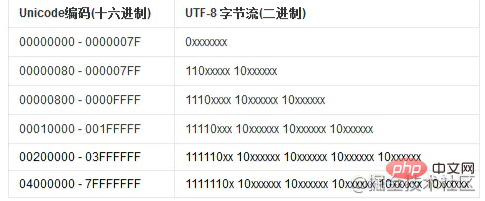Let's talk about encoding in Node.js Buffer
This article will take you to understand the encoding in Node.js Buffer, I hope it will be helpful to everyone!

The smallest unit of a computer is a bit, that is, 0 and 1, which are corresponded to high and low levels on the hardware. However, only one bit represents too little information, so 8 bits are specified as one byte. After that, various information such as numbers and strings are stored based on bytes. [Recommended study: "nodejs Tutorial"] How to store
characters? It relies on encoding. Different characters correspond to different encodings. Then when rendering is needed, the font library is checked according to the corresponding encoding, and then the graphics of the corresponding characters are rendered.
Character set
The character set (charset) was originally ASCII code, which is abc ABC 123 and other 128 characters, because the computer was first invented in the United States. Later, Europe also developed a set of character set standards called ISO, and later China also developed a set of character set standards called GBK.
The International Organization for Standardization felt that we couldn’t each have one, otherwise the same code would have different meanings in different character sets, so we proposed unicode coding to include most of the world’s codes, so that each character Only unique encoding.
But ASCII code only requires 1 byte to store, while GBK requires 2 bytes, and some character sets require 3 bytes, etc. Some only need one byte to store but store 2 Bytes, which is a waste of space. So there are different encoding schemes such as utf-8, utf-16, utf-24, etc.
utf-8, utf-16, and utf-24 are all unicode encodings, but the specific implementation plans are different.
UTF-8 In order to save space, a variable-length storage scheme from 1 to 6 bytes is designed. UTF-16 is fixed at 2 bytes, and UTF-24 is fixed at 4 bytes.

Finally, UTF-8 is widely used because it takes up the least space.
Node.js Buffer encoding
Each language supports character set encoding and decoding, and Node.js does the same.
Node.js can use Buffer to store binary data, and when converting binary data to a string, you need to specify the character set. Buffer's from, byteLength, lastIndexOf and other methods support specifying encoding:
The specifically supported encodings are:
utf8, ucs2, utf16le, latin1, ascii, base64, hex
Some students may find that: base64 and hex are not character sets Ah, why are you here?
Yes, in addition to the character set, the byte-to-character encoding scheme also includes base64 for converting to plaintext characters, and hex for converting to hexadecimal.
This is why Node.js calls it encoding instead of charset, because the supported encoding and decoding schemes are not just character sets.
If encoding is not specified, the default is utf8.
1 2 3 |
|
Encoding source code
I went through the Node.js source code about encoding:
This section implements encoding: https: //github.com/nodejs/node/blob/master/lib/buffer.js#L587-L726
You can see that each encoding implements encoding, encodingVal, byteLength, write, slice, indexOf. Several APIs, because these APIs use different encoding schemes, will have different results. Node.js will return different objects according to the incoming encoding. This is a polymorphic idea.
1 2 3 4 5 6 7 8 9 10 11 12 13 14 15 16 17 18 19 20 21 22 23 24 25 26 27 28 29 30 31 32 33 34 35 36 37 38 39 40 41 42 43 44 45 46 47 48 49 50 51 52 53 54 55 56 57 58 59 60 61 62 63 64 65 66 67 68 69 70 71 72 73 74 75 76 77 78 79 80 81 82 83 84 85 86 87 88 89 90 91 92 93 94 95 96 97 98 99 100 101 102 103 104 105 106 107 108 109 110 111 112 113 114 115 116 117 118 119 120 121 |
|
Summary
The smallest unit for storing data in a computer is a bit, but the smallest unit for storing information is a byte. The mapping relationship based on encoding and characters is realized again. Various character sets, including ascii, iso, gbk, etc., and the International Organization for Standardization proposed unicode to include all characters. There are several unicode implementation solutions: utf-8, utf-16, utf-24, and they use different characters respectively. Number of sections to store characters. Among them, utf-8 is variable length and has the smallest storage volume, so it is widely used.
Node.js stores binary data through Buffer, and when converting it to a string, you need to specify an encoding scheme. This encoding scheme not only includes character sets (charset), but also supports hex and base64 schemes, including:
utf8, ucs2, utf16le, latin1, ascii, base64, hex
We looked at the Node.js source code of encoding and found that each encoding scheme will be used to implement a series of APIs. This is a Polymorphic thoughts.
Encoding is a concept that is frequently encountered when learning Node.js, and the encoding of Node.js does not only include charset. I hope this article can help everyone understand encoding and character sets.
For more programming-related knowledge, please visit: Introduction to Programming! !
The above is the detailed content of Let's talk about encoding in Node.js Buffer. For more information, please follow other related articles on the PHP Chinese website!

Hot AI Tools

Undresser.AI Undress
AI-powered app for creating realistic nude photos

AI Clothes Remover
Online AI tool for removing clothes from photos.

Undress AI Tool
Undress images for free

Clothoff.io
AI clothes remover

Video Face Swap
Swap faces in any video effortlessly with our completely free AI face swap tool!

Hot Article

Hot Tools

Notepad++7.3.1
Easy-to-use and free code editor

SublimeText3 Chinese version
Chinese version, very easy to use

Zend Studio 13.0.1
Powerful PHP integrated development environment

Dreamweaver CS6
Visual web development tools

SublimeText3 Mac version
God-level code editing software (SublimeText3)

Hot Topics
 1392
1392
 52
52
 36
36
 110
110
 Detailed graphic explanation of the memory and GC of the Node V8 engine
Mar 29, 2023 pm 06:02 PM
Detailed graphic explanation of the memory and GC of the Node V8 engine
Mar 29, 2023 pm 06:02 PM
This article will give you an in-depth understanding of the memory and garbage collector (GC) of the NodeJS V8 engine. I hope it will be helpful to you!
 An article about memory control in Node
Apr 26, 2023 pm 05:37 PM
An article about memory control in Node
Apr 26, 2023 pm 05:37 PM
The Node service built based on non-blocking and event-driven has the advantage of low memory consumption and is very suitable for handling massive network requests. Under the premise of massive requests, issues related to "memory control" need to be considered. 1. V8’s garbage collection mechanism and memory limitations Js is controlled by the garbage collection machine
 Let's talk about how to choose the best Node.js Docker image?
Dec 13, 2022 pm 08:00 PM
Let's talk about how to choose the best Node.js Docker image?
Dec 13, 2022 pm 08:00 PM
Choosing a Docker image for Node may seem like a trivial matter, but the size and potential vulnerabilities of the image can have a significant impact on your CI/CD process and security. So how do we choose the best Node.js Docker image?
 Let's talk in depth about the File module in Node
Apr 24, 2023 pm 05:49 PM
Let's talk in depth about the File module in Node
Apr 24, 2023 pm 05:49 PM
The file module is an encapsulation of underlying file operations, such as file reading/writing/opening/closing/delete adding, etc. The biggest feature of the file module is that all methods provide two versions of **synchronous** and **asynchronous**, with Methods with the sync suffix are all synchronization methods, and those without are all heterogeneous methods.
 Node.js 19 is officially released, let's talk about its 6 major features!
Nov 16, 2022 pm 08:34 PM
Node.js 19 is officially released, let's talk about its 6 major features!
Nov 16, 2022 pm 08:34 PM
Node 19 has been officially released. This article will give you a detailed explanation of the 6 major features of Node.js 19. I hope it will be helpful to you!
 Let's talk about the GC (garbage collection) mechanism in Node.js
Nov 29, 2022 pm 08:44 PM
Let's talk about the GC (garbage collection) mechanism in Node.js
Nov 29, 2022 pm 08:44 PM
How does Node.js do GC (garbage collection)? The following article will take you through it.
 Let's talk about the event loop in Node
Apr 11, 2023 pm 07:08 PM
Let's talk about the event loop in Node
Apr 11, 2023 pm 07:08 PM
The event loop is a fundamental part of Node.js and enables asynchronous programming by ensuring that the main thread is not blocked. Understanding the event loop is crucial to building efficient applications. The following article will give you an in-depth understanding of the event loop in Node. I hope it will be helpful to you!
 What should I do if node cannot use npm command?
Feb 08, 2023 am 10:09 AM
What should I do if node cannot use npm command?
Feb 08, 2023 am 10:09 AM
The reason why node cannot use the npm command is because the environment variables are not configured correctly. The solution is: 1. Open "System Properties"; 2. Find "Environment Variables" -> "System Variables", and then edit the environment variables; 3. Find the location of nodejs folder; 4. Click "OK".




